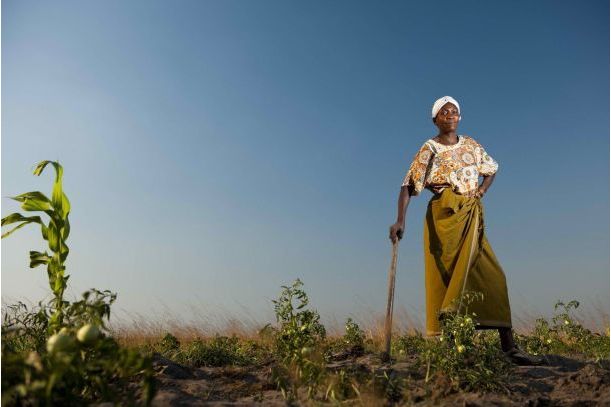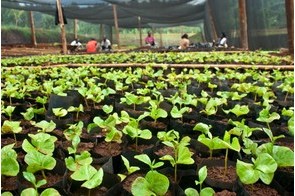The need for women entrepreneurs, innovators and leaders in Africa’s agriculture

Summary
Women contribute on the average 40 per cent labour participation in the agriculture sector in sub-Saharan Africa. Nevertheless, there is still a yawning gender gap in the agriculture sector.
In many countries across the globe, the majority of people working in the agriculture sector are women. But according to the Food and Agriculture Organisation of the United Nations (FAO), women on the average account for 43 per cent of agricultural labour force in developing countries.
In a recent report by the World Bank on women’s labour involvement in agriculture, based on a survey by the Living Standards Measurement Study – Integrated Surveys on Agriculture (LSMS-ISA), women’s contribution varies from country to country. The six sub-Saharan African (SSA) countries covered by the study were Ethiopia, Malawi, Niger, Nigeria, Tanzania and Uganda. Uganda had the highest female labour input of 56 per cent, followed by Tanzania and Malawi which both had 52 per cent women shares.
Ethiopia and Niger recorded 29 and 24 per cent, respectively, while Nigeria had 37 per cent women’s labour input in crop production. The report also showed that women’s involvement in food production was as high as 51 per cent in the Southern region of Nigeria, while a decline to 32 per cent was observed in the Northern region of the country. Therefore, women’s participation can vary significantly within the same country.
Overall, women contribute on the average 40 per cent labour participation in the agriculture sector in SSA. Nevertheless, there is still a yawning gender gap in the agriculture sector.
In small scale or subsistence farming, rural women play pivotal roles in the production of staple food crops, poultry, fisheries and livestock farming. They are also prominently involved in processing and storage activities. Indeed, women’s labour is most visible in processing of farm produce and value addition. Using cassava as an example, women are largely involved in processing its roots to other food products consumed locally, from sourcing water and firewood, to peeling the roots, grating, grinding and roasting the fermented paste to granular flour known as “garri.” Women also take the lead when it comes to marketing agricultural produce.
Despite the vital contributions of women in both rural and urban centres to food production and its availability, women face more constraints in their economic and agricultural productivity compared to men. One of such constraints is the multiple gender roles that women play in households, including reproductive roles -- like bearing and raising children -- productive works for the family, household maintenance, as well as other domestic tasks. The burden of reproduction and care-giving activities generally limit the productivity of women and their ability to be fully involved in economic activities.
Most of the time, these factors affect the desire of women to pursue higher education which will help to broaden their knowledge, hone important skills, increase their ability to develop and adopt new innovations, increase their employment opportunities and enable them to create more avenue to earn more income. Meanwhile, encouraging women as much as we support men to pursue higher education has other societal and economic returns. Societies where more women acquire higher education are better positioned to achieve equality in the work force. Such educated women will be able to show more interest in nation building. They will also possess the educational requirements to take up certain leadership roles. Other benefits are reduced child marriage, reduction in maternal death rates and a higher tendency to control excessive population growth.
One other formidable challenge to women’s agricultural productivity is limited access to funding and other resources. Women farmers are often unable to secure credits from financial institutions. In some cases, getting support from government initiatives to assist farmers is also difficult for women. Creditors are also sceptical about giving loans to women because they doubt their ability to pay back. This would appear to be well founded, as the gender roles played by women, including care giving, reduce the amount of time they have left for economic activities that generate incomes. These roles also limit their mobility, preventing the women from travelling long distances in search of opportunities to obtain loans and other supports from financial institutions, make deposits or even pay back their loans.
Such situations make it difficult for women to take up business opportunities that require substantial funding, such as owning large poultry farms, well-equipped processing facilities and mechanized farms. In many parts of SSA, women still suffer from discriminations in terms of access to land, useful information and extension services.
Economically empowering women is essential to increasing productivity generally. Removing the barriers to women’s access to finance, other inputs and services, has an overall societal benefit. Women can make more profit in their businesses if they have the necessary inputs and support, and such profits are often reinvested into taking better care of their children. Several studies have affirmed that women spend most of their earnings and savings on ensuring that their kids feed well, have good health and obtain an education. When women as caregivers have the financial resources to do the job, the burden of caregiving falls drastically.
To increase agricultural productivity, certain technological inputs and know-how are required and access to them should not be restricted to men. Women are mostly underrepresented as beneficiaries of high-tech trainings. Equitable access to beneficial trainings and innovative skill acquisition programs organised by government and other bodies should be emphasized and implemented. It is important to make technologies that reduce labour, improve productivity and reduce energy also available to women farmers and processors.
Whether in rural or urban locations, women are typically on the frontline of agriculture when it comes to labour. But the reverse is the case when it comes to innovation, leadership and decision making in agriculture. Women’s participation at this level is very low. Their concerns and thoughts as people involved in every aspect of the food value chain, from farm to fork, are scarcely heard at national and global levels. In this situation, a mismatch between the ideas of people who are involved in the field activities (many women) and those who make most of the decisions and policies (mainly men) is almost inevitable.
The rapid growth in global population especially in sub-Saharan Africa underscores the need to move from manual labour to mechanized agriculture. By 2050, the world’s population is expected to reach 9.7 billion with an increase of 2.37 billion from the current number. Africa alone is projected to contribute up to 54 per cent of this increase with Nigeria – already by far the most populous African country – taking the lead. Because women are the ones who are chiefly involved in agricultural processing, cooking and determining what the household feeds on, their ideas and opinions are crucial for innovations related to food and child nutrition. This means that we cannot continue to have our women at the low value end of food production.
We also need to innovate to tackle the challenges of climate change. To be successful in this existential fight, we can’t afford to leave behind women, who constitute about half of our working population. Women should also be empowered to be more involved in the development of digital tools, precision agriculture techniques, biological innovations, improved data collection, data analysis and usage, technologies to reduce greenhouse gas emissions, improved plant breeding techniques, nutrient optimization, and techniques to manage weather changes, among other 21st century agricultural practices.
More women must be supported with resources to contribute tangibly to food security. As a result of such supports, women’s participation in feeding our teeming population will be increased. We should be looking to raise more women ‘agripreneurs’ who can access modern innovations and machineries to boost their productivity. Like men, more women agricultural scientists should be supported and given access to trainings, skills and funding to birth ground-breaking innovations within the continent to achieve food security.
Mojisola Karigidi, a Financial Nigeria Columnist, is a Nigerian biochemist and the founder and product developer at Moepelorse Bio Resources. She is also a Global Innovation Through Science and Technology (GIST) awardee, and an Aspen New Voices fellow.
Related
-
Uganda's Grainpulse receives $11 million from IFC to support farmers
The investment will enable Grainpulse to support its expansion and increase food production in Uganda.
-
IFAD to provide $40mn loan for Sub-Saharan Africa Aquaculture Programme
IFAD stated that the programme will pay special attention to women and youth.
-
ICRISAT launches 2025–2030 strategy to shape the future of agriculture
Calls for strategic partnerships for a food-secure and sustainable future for over 2 billion people living in the drylands.








